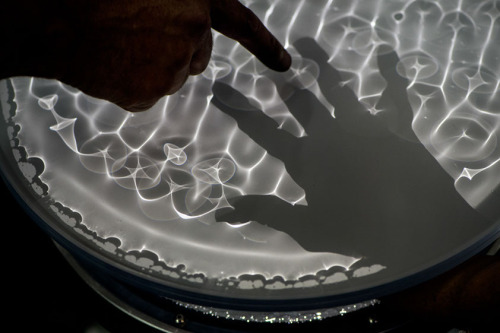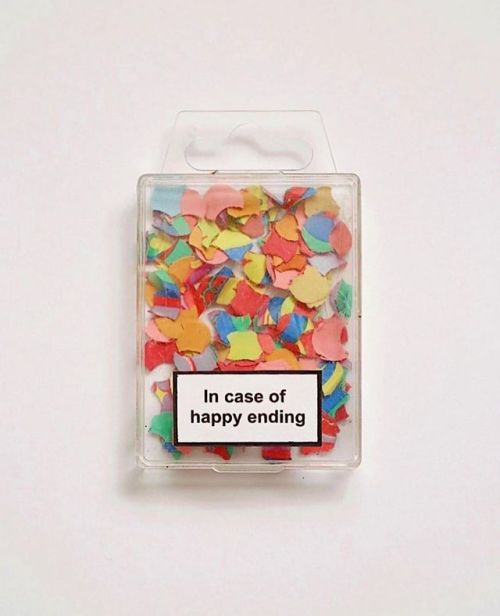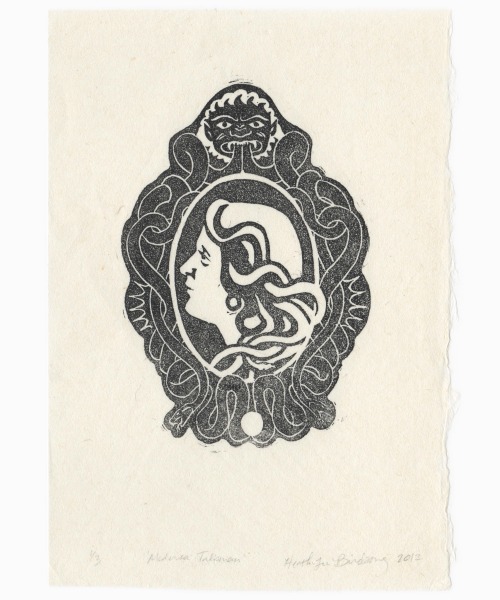The Latest
Drip Chamber (2011), (viscous liquids create a mesmerizing light display), Exploratorium, San Francisco, CA
(via garadinervi)
𝘔𝘦𝘥𝘶𝘴𝘢 𝘛𝘢𝘭𝘪𝘴𝘮𝘢𝘯 by Heather Lee Birdsong, 2012, relief print on mulberry paper, 8.5 x 5.75 inches (paper size), edition of 3 plus 2 AP.
Originally an ancient monster with goggling eyes and prominent fangs that served as a protective symbol, Medusa morphed into a lethal and victimized beauty. According to later mythology, she was raped by Poseidon and beheaded by Perseus with the help of Athena, female upholder of patriarchy (and favorite daughter of Zeus). Many 20th and 21st century feminists have reclaimed Medusa as a symbol of rage and survival.
Contemporary reinventions of the myth typically overlook Athena’s complicity in the patriarchal domination of and violence against Medusa, though that strikes me as a particularly terrible part of the tale. It also feels the most relevant: it is a pattern we see repeated in every story of the powerful abusing those less powerful. It makes us feel alone even when we are not, and undermines the seeking of justice and redress. It is up to each of us to be wary of our own complicity when tested. I think of this artwork as a talisman for this kind of wariness, incorporating both aspects of Medusa’s myth.
«At the Internet Archive, this is how we digitize a book. We never destroy a book by cutting off its binding. Instead, we digitize it the hard way—one page at a time. We use the Scribe, a book scanner our engineers invented, along with the software that it runs. Our scanning centers are located in universities and libraries around the world, from Boston Public Library to the University of Toronto to the Wellcome Library and beyond. Eliza is one of our fastest and most accurate scanners. Next she will execute quality control checks and fix any errors. Then she ships the book back to our Physical Archive for long-term preservation. Now imagine this: scanners like Eliza have done this 2,000,000 times. That’s what it takes to provide you with a free digital library.» – Plus Internet Archive’s Modern Book Collection Now Tops 2 Million Volumes, by Chris Freeland, February 3, 2021
♥
(via garadinervi)
We recently refreshed our collection exhibition An Incomplete History of Protest. See new additions by artists including Jeffrey Gibson, Robert Morris, Guerrilla Girls, and Kara Walker.
[Jeffrey Gibson (b. 1972), I Know You Have A Lot of Strength Left, 2017. Rawhide, acrylic, graphite, metal tacks, and canvas on panel Overall: 82 1/8 × 65 1/8 × 2 3/4in. (208.6 × 165.4 × 7 cm). Whitney Museum of American Art; gift of the artist T.2017.582]
Glenn Ligon, Give us a Poem (Palindrome #2), 2007
“Glenn Ligon made this neon piece […] in 2007, and I saw it a little while back on the wall of the Studio Museum in Harlem, where it’s part of the permanent collection. The work is built around an incident that occurred at Harvard in 1975, when Muhammad Ali had just finished a speech and a student in the audience asked him to improvise a poem: ‘Me/We’ was the pithy verse Ali offered. Even then, at the height of the Black Power movement, it was an intriguingly opaque statement that could have been read as a gesture of solidarity between the black boxer and his white audience, or as an underlining of their difference. In Ligon’s work, the two words become a visual palindrome, of sorts – symmetrical top and bottom – and alternate being lit (white) and unlit (black), which just increases the tension inherent in them. In 2014, in a museum in Harlem, it strikes me that the tension is between the artist and the audience he addresses – with the issue of race still there, but now wrapped up in larger issues of aesthetic communities and the class, and color, they imply.“ Blake Gopnik, The Daily Pic
‘‘Everything #2.8’’ (2007) by Adrian Piper









![grupaok:
“Glenn Ligon, Give us a Poem (Palindrome #2), 2007
“Glenn Ligon made this neon piece […] in 2007, and I saw it a little while back on the wall of the Studio Museum in Harlem, where it’s part of the permanent collection. The work is built...](https://64.media.tumblr.com/a66d7c7c3336ed1924ac7449a5f2b114/tumblr_nfs9dsbYoY1r70t2xo1_500.jpg)

![[[MORE]]](https://64.media.tumblr.com/485551f877d6bee77a8bbb02b5fe2554/2b3716bf3e7ed3d9-2f/s500x750/759e8ea78f67cc1fe32a77e86c6fa06616f6b145.gifv)
